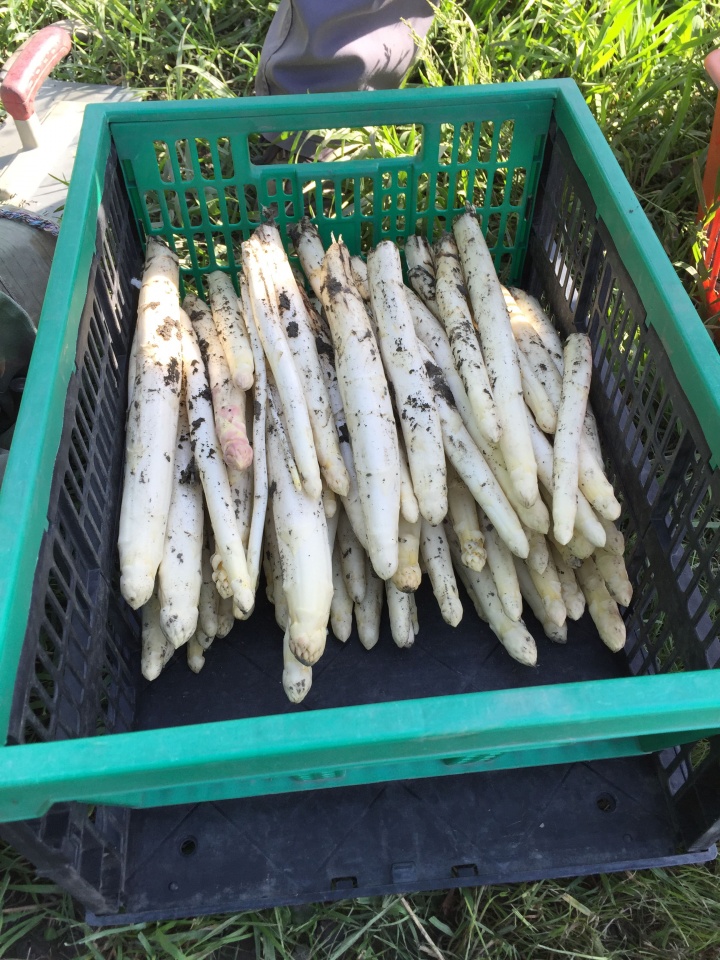Spargel Ziit - Asparagus Season in Werdenberg and the Rhine Valley

Why are asparagus so expensive? Join me as I "stab" asparagus in the Wartau fields of Anita and Hans Gabathuler-Reich.
Chalkboards announcing ‘Spargel Ziit’ flank the entrances to local restaurants. Coop and Migros advertise it - everywhere. Why do they claim the asparagus season has just begun? Asparagus have been available since February in the supermarkets.
But those are not local asparagus, they are imported. The "queen of the veggies" can be harvested each morning and can be on your dinner plate by evening. Fresh spears tantalize the taste buds and are ecologically superior to the imported variety.
But why are asparagus so expensive? And why is the season so short?
My curiosity led me to Anita and Hans Gabathuler - Reich in Wartau.
Anita and Hans have been in the asparagus business since 1992. In contrast to Stefan Britischi in Diepoldsau, who farms 15 hectares of “underground heated” asparagus fields with 30 workers, Anita and Hans work four fields in Wartau with just two workers.
Anita, Hans and Fritz have already worked two fields before I arrived at 7:00 o'clock. Their morning kicks off no later than 5: 30 am.
All I see are mounds, about twenty meters long, covered with tarps. The tarps are white on one side and black on the other. Anita explains the multitasker. “Primarliy the tarps protect the field against weeds which are annoying and rob the asparagus of vital nutrients. If the weather is too cold the tarp produces a "greenhouse effect" and it reflects the sun and cools off the plants in hot weather. Yet, their main job is to spurn growth. At the right temperature, the asparagus can grow ten to fifteen cm per night.”
Vicki
Why do you say asparagus “stecken” (stick/stab) in German instead of picking asparagus?
Anita
White asparagus grows under the soils surface. The asparagus is a chute off of the top of the bushy plant beneath. You have to cut the spear from the plant. You need a special tool, "an asparagus knife" for the job.

Anita explains her team's efficient approach.
"Fritz removes the tarp from one row. Hans and I "stab/stick" the asparagus. While we are harvesting, Fritz uncovers the next row so that when we finish we can move to the next row without losing any time. He re-covers the first row... and so on... until we finish all twenty rows.
Vicki
Ok, let’s get started.
Photo
Anita
First, we look for a plant. Do you see that dark spot?

Vicki
All I see is a bunch of dirt and not an asparagus tip in sight.
You need trained eye and a steady hand to “stab” asparagus. Unfortunately, I don't have either.
Anita
That comes with experience.
Start digging with your hands and carefully remove the soil.

If you see a tip dig around it going deeper as you go, but be careful not to harm the plant. Determine if the spear is large enough for harvest. If it is, take the "asparagus knife", place it two cm underneath the plant, stab through the base of the spear until the asparagus breaks off. Remove the asparagus and then put the soil back into the hole.
Vicki
Wow, that doesn't just need a good eye, it takes some muscle.
Anita
Yes, otherwise you break the asparagus.
Vicki
Anita makes me aware that several spears can grow in one hole. I stopped digging so fiercely, out of fear I will break this “white gold”.

Vicki
How much asparagus do you harvest per day?
Anita
A plant can produce one kilo per season." We have 400 plants per row planted, 8000 per field.
Depending on the weather, we reap 40-100 kilos each day.
Vicki
The season begins mid-April and ends on the 24th June. Why is the season so short? Why does the season end on June 24? Is it due to the Johannestag or the Schafskälte?
Anita
Actually neither. The asparagus is a perennial plant. It needs approximately 100 days before the first frost to regenerate to produce strong spears in the next season. The plant can produce asparagus for ten to fifteen years. When a plant produces only thin spears, we remove it and replace it with a new one. We also rotate the fields because asparagus takes a lot out of the soil. One field needs at least 3 years to rejuvenate.
Vicki
My next asparagus spear is a real Wartau Spargel says Anita, "It has a red tip - "köpfli".

It is almost 8:00 am. In the last hour, I've managed to “stab” less than a kilo of asparagus. OK, I asked a lot of questions. Between my questions and correcting my mistakes, Anita filled a container. And now she only has 19 rows to go.
Your work isn't finished in the field is it?
Anita
No, now we transport the asparagus, wash and pack them according to the orders we have received. Landi, the restaurants Kurhaus Alvier and the Mühle Oberschan as well as private customers order from us.
.jpg)
After just one hour I know why asparagus is so expensive. It is not only 'hand and back' work, it is also delicate work. Now, as I pay 18 CHF for a kilo asparagus, I appreciate the work behind it.
I invite you to discover the taste for local asparagus. You too can place an order;
Anita and Hans Gabathuler-Reich
9476 Fontnas - Tel. 081 078 32481
If you prefer to leave the work to a chef, reserve a table at the Alte Mühle Oberschan or Churhaus Alvier for a culinary experience - Werdenberger style.
I'm going home to peel my asparagus. Should I serve them with an orange hollandaise or wasabi mayonnaise? I portion of smoked ham and melon will be the perfect accompaniment. Yum! En Gueta Miteinander.
© Copyright Vicki Gabathuler, 2016